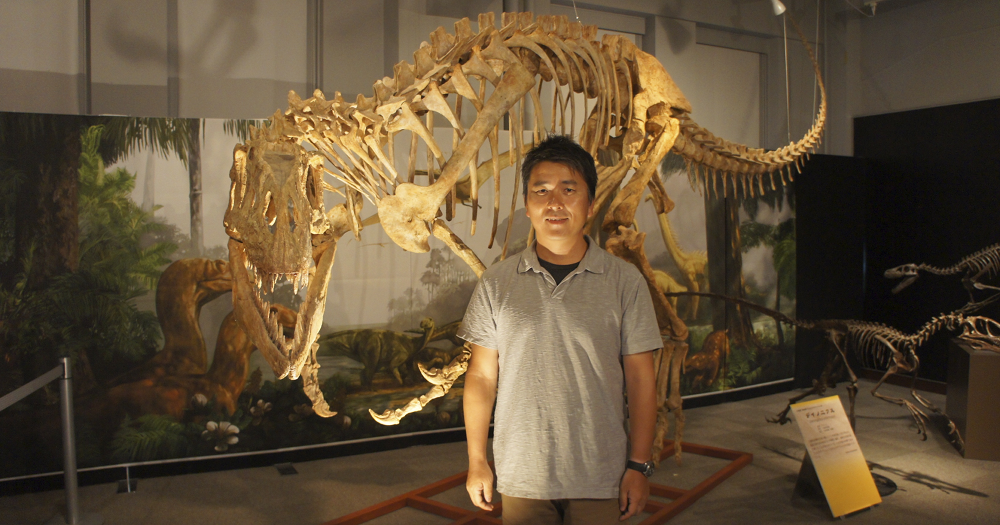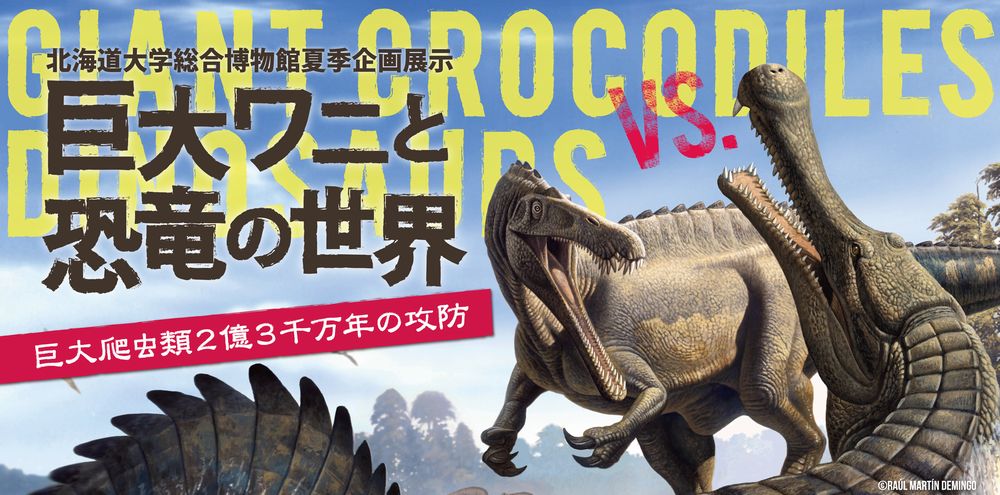Spotlight on Research #3 Were Dinosaurs adaptable enough to survive the meteor?
Research Highlight | July 23, 2013
-
 Yoshitsugu Kobayashi standing in front of the skeleton of an afrovenator dinosaur.
Yoshitsugu Kobayashi standing in front of the skeleton of an afrovenator dinosaur. -
 The Hokkaido University Museum Exhibition Poster
The Hokkaido University Museum Exhibition Poster
Based on the third floor of the Hokkaido University museum, Assistant Professor Yoshitsugu Kobayashi is a dinosaur hunter. His searches for the fossilised remains of Earth’s previous rulers has taken him on a pan Pacific sweep of countries that has most recently landed him in Alaska.
With its freezing winters and long nights, Alaska is not the first place one might suppose to find the remains of beasts resembling giant lizards. Nor has the landmass moved from more comfortable tropics over the last 66 million years since the dinosaurs became extinct. To understand how these creatures could have thrived in such a hostile environment, Yoshitsugu suggests that our view of dinosaurs needs to change.
Dinosaurs have long been considered the enormous ancestors of cold blooded reptiles. Unable to control their own body temperature, these creatures would need to live in warm climates to maintain a reasonable metabolism. Finding fossils in Alaska therefore, presents scientists with some problems.
“To survive winters in Alaska, the dinosaurs would need to be warm blooded,” Yoshitsugu explains. “This allows them to adapt more easily to different environments.”
Which brings us to Yoshitsugu’s next big question; to what extent were the dinosaurs able to flourish in different living conditions?
To investigate this, Yoshitsugu and his team examined the fossils found in Alaska and compared them with known dinosaur groups elsewhere in the world. There were three main possibilities for their findings:
The Alaskan population of dinosaurs could match that of North American dinosaurs at lower latitude, implying that same group had migrated north.
Rather than North American, the dinosaurs could be kin to those found in Asia. This would require a migration across from Russia to Alaska and its likelihood is determined by the condition of the Bering Strait; an 82 km stretch between Russia’s Cape Dezhnev and Cape Prince of Wales in Alaska. In the present time this gap is a sea passage but in the past, a natural land bridge has existed and is thought to be responsible for the first human migration into America. Could the dinosaurs have taken the same path millions of years before?
The third option is that the Alaskan dinosaurs resemble neither their North American or Russian cousins and a different kind of dinosaur inhabited these frozen grounds.
Examining their finds from this region, Yoshitsugu’s team concluded that what they had were North American dinosaurs. This meant that dinosaurs –like humans– were capable of living across an incredibly wide range of environments, with different climates, food sources and dangers.
“People often picture the dinosaurs as having small brains,” Yoshitsugu amends. “But the same dinosaurs lived in very different places. They were intelligent and adaptable.”
This adaptability has one very important consequence; the meteor that hit the Earth 66 million years ago is unlikely to have been solely responsible for the dinosaurs’ demise.
As it crashed into the Earth, the meteor raised a huge cloud of dust that blotted out the sun, creating a cold and dark new world. Had the dinosaurs been cold blooded, such a massively extended winter would have proved fatal, but Yoshitsugu’s research supports suggestions that not only were the dinosaurs warm blooded, they were also equipped to deal with this new harsh environment.
This doesn’t mean the meteor failed to have an impact on the dinosaur population. With a drop in sunlight, the vegetation would have decreased, reducing the food source for herbivores and subsequently, the carnivores who fed on them. Yet, it does appear that the dinosaurs could have survived if this were the only disaster.
So what else could have happened to destroy this species? Yoshitsugu pointed to two other possible causes: The first is major volcanic activity in the vast mountain range that covers large parts of India. In a series of prolonged eruptions that persisted for thousands of years, lava poured over hundreds of miles of land and the ejected carbon and sulphur dioxide combined to acidify the oceans. The impact on life was catastrophic and longer lasting than that from the meteor.
The second possible cause of dinosaur extinction is linked with the drop in the sea levels that occurred towards the end of the 66 million year mark. As the water receded, land bridges were formed between the continents, allowing dinosaurs to travel freely across the globe. The result was a drop in genetic diversity among the dinosaur species. The same effect is seen today if a foreign breed of animal is introduced into a new ecosystem. In the UK, the introduction of the eastern grey squirrel has driven the native red squirrel to the point of extinction. The grey squirrel can digest local food sources more effectively and also transmits a disease fatal to red squirrels, driving down their numbers. This uniformity in dinosaur genetics made them highly susceptible to eradication, since a physiological or environmental impact will equally affect the entire, near-identical, population.
It was most likely a combination of these three catastrophes that caused the death of the dinosaurs, Yoshitsugu concludes.
However, dinosaurs were not the only giants walking the Earth 230 million years ago. Living alongside these warm blooded creatures were genuine cold blooded reptiles; the giant crocodiles. With limbs that came out from the body sideways, not straight, these huge beasts were a distinct species from the dinosaurs.
Exactly how these monsters dwelt together is currently being explored in the new exhibit at the Hokkaido University Museum, ‘Giant Crocodiles vs Dinosaurs’, which opened last Friday. The exhibit includes full sized casts of both adult and juvenile crocodiles and dinosaurs, describing their location and where they overlapped. There is also a movie sequence Yoshitsugu was involved in creating that shows a simulated fight between a giant crocodile and a T-Rex over prey.
This unique view of the world of the dinosaurs is open until October 27th.
We hope to see you there!
Author Dr Elizabeth Tasker
